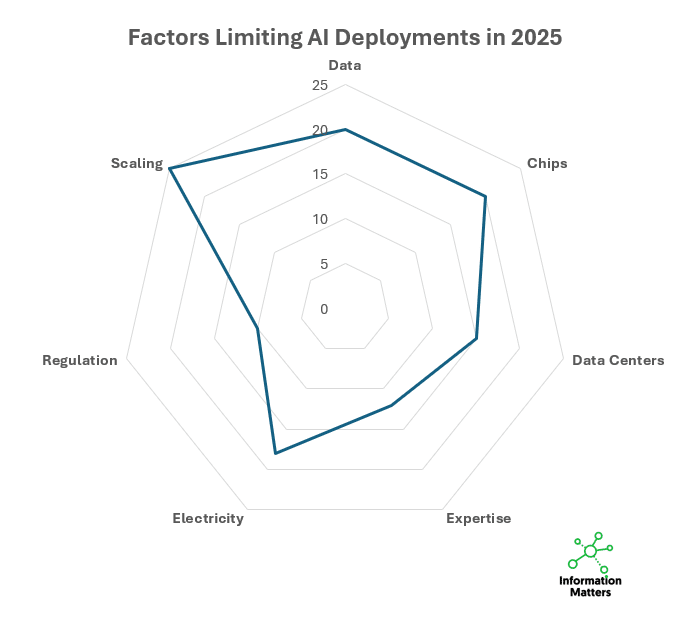What key factors will limit AI innovation and deployments in 2025?
We’ve looked at the research from surveys and interviews with AI developers, CIOs, CEOs, academics and infrastructure providers and mapped the results onto this radar chart.

Scaling Problems of AI
As the chart shows, scaling is going to be a key factor limiting innovations in frontier model LLMs. Ilya Sutskever, co-founder of AI labs Safe Superintelligence (SSI) and OpenAI recently stated in late 2024 that results from scaling up pre-training had plateaued.
Researchers from the Universities of Toronto and Oxford published research in early 2024 showing that relying on synthetic data generated by LLMs results in negative feedback loops which degrade results and can lead to model collapse.
Data shortages for AI training
Alongside chip shortages, the rapidly diminishing stocks of data available for training LLMs is the second largest factor impacting AI innovation in 2025. Demis Hassabis, CEO and co-founder of Google DeepMind has argued that AI developers are running out of data. “Everyone in the industry is seeing diminishing returns” he told the New York Times just before accepting a Nobel Prize for his work on AI.
As content owners impose more restrictions on how AI companies can use their data, this problem will accelerate in 2025 with synthetic data, as discussed above, offering limited scope for solving these shortages.
Chip availability for AI developers
According to TSMC, the world’s largest manufacturer of semiconductors, global demand for AI chips will continue to outstrip supply until the end of 2025 or 2026. C. C. Wei, TSMC’s CEO recently stated,
I tried to reach the supply and demand balance, but I cannot today. The demand is so high, I had to work very hard to meet my customer’s demand. We continue to increase.
NVIDIA’s unquenchable thirst for TSMC’s chips for its GPUs is driving much of these shortages with increasing demand also coming from other large-scale develpers seeking to build their own alternatives to NVIDIA’s offerings.
AI Skills
Demand for AI developers by providers of large frontier models including OpenAI and Anthropic coupled with the need for these skills within large enterprises looking to build and roll out AI solutions internally are creating bottlenecks to AI deployment projects. According to 2024 McKinsey research, about 40% of the senior executives they surveyed are experiencing difficulties finding staff with the right skills to build and deploy AI solutions. These shortages will continue into 2025 and 2026 at least as the pipeline for training suitably skilled experts works through.
Demand for electricity puts pressure on grids
Power infrastructure provider, Schneider, recently forecast that global AI energy consumption would rise from 100 TWh in 2025 to 880 TWh by 2030. Without significant increases in generation capacity and grid upgrades to get the power to where it is needed, energy is going to become a significant limiter for AI innovation in the coming years.
Recent announcements by large technology companies including Meta and Amazon they are exploring building their own nuclear generators indicate the seriousness of this problem. National and global coordination will be needed to prevent localised power shortages.
Regulation
With the incoming Trump administration it looks like regulatory restrictions on AI developments, in the US at least, may take a back seat. Donald Trump has announced plans to repeal Joe Biden’s executive order on AI. The main uncertainty is the influence of Elon Musk on future policy. While he is unlikely to lobby for tighter controls on AI developers in general, his unpredictability could be a factor in forcing changes at a national level.
In Europe the EU AI Act will start to be enforced in 2025 with AI systems deemed to pose unacceptable risks being banned. The extent to which this is enforced and how it might impact AI developers outside the EU is likely to be limited in the short term. However, as the impact of AI systems becomes more apparent over the next several years we might expect greater demand amongst EU citizens for action to be taken if negative results are seen.
Can data centers keep up with demands of AI?
Recent research of business leaders by the Omnia Strategy Group cited that only 28% of respondents believed data centers were fully prepared to handle AI’s computational demands. 48% of respondents felt that integrating AI and machine learning workloads remained one of the biggest challenges for data centers.

